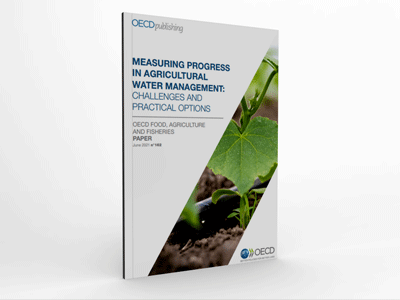Water and agriculture
Managing water sustainably is key to the future of food and agriculture
Agriculture production is highly dependent on water and increasingly subject to water risks. It is also the largest using sector and a major polluter of water. Improving agriculture’s water management is therefore essential to a sustainable and productive agro-food sector.
Agriculture is expected to face increasing water risks in the future
In recent years, agricultural regions around the globe have been subject to extensive and increasing water constraints. Major droughts in Chile and the United States have affected agricultural production while diminishing surface and groundwater reserves. These and other extreme weather events, like floods or tropical storms, are also expected to be more frequent. Climate change is projected to increase the fluctuations in precipitation and surface water supplies, reducing snow packs and glaciers and affecting crop’s water requirements.
Coupled with these changes, farmers in many regions will face increasing competition from non-agricultural users due to rising urban population density and water demands from the energy and industry sectors. In addition, water quality is likely to deteriorate in many regions, due to the growth of polluting activities, salination caused by rising sea levels and the abovementioned water supply changes.
These water challenges are expected to strongly impact agriculture – a highly water-dependent sector – undermining the productivity of rain-fed and irrigated crops and livestock activities particularly in certain countries and regions. These changes could in turn further impact markets, trade, and broader food security. An OECD assessment of future water risk hotspots projects that without further action, Northeast China, Northwest India, and the Southwest United States will be among the most severely affected regions, with domestic and global repercussions.
Agriculture both contributes to and faces water risks
For as much as agriculture is impacted by these changes, it also contributes to the problem as a major user and polluter of water resources in many regions. As such, agriculture has a central role to play in addressing these challenges.
Irrigated agriculture remains the largest user of water globally, a trend encouraged by the fact that farmers in most countries do not pay for the full cost of the water they use. Agriculture irrigation accounts for 70% of water use worldwide and over 40% in many OECD countries. Intensive groundwater pumping for irrigation depletes aquifers and can lead to negative environmental externalities, causing significant economic impact on the sector and beyond. In addition, agriculture remains a major source of water pollution; agricultural fertiliser run-off, pesticide use and livestock effluents all contribute to the pollution of waterways and groundwater.
What should governments do to confront water issues?
The challenges that lie ahead are both extremely complex and locally diverse. It will be important for policymakers to focus on efforts that increase the overall efficiency of water use by the agricultural sector, reduce the sector’s impact on freshwater resources, and improve its resilience to water risks. To this end, the OECD advocates for multiple policy responses at different levels, each adapted to specific water resource systems.
In order to facilitate a transition to a more sustainable and productive agricultural sector that is resilient to water risks, governments should act at the farm, watershed and national levels to (1) strengthen and enforce existing water regulations, (2) create incentives for farmers to improve their water use and better manage the use of polluting agricultural inputs; and (3) remove policies that support excessive use of water and polluting activities.
To assist policy makers in addressing this challenge, OECD analysis and indicators contribute to formulating policy responses, defining pathways to make the necessary policy changes, and facilitating their implementation to move agriculture towards the sustainable management of water. OECD's work on agriculture and water is also highlighted in the 2016 OECD Council Recommendation on Water.
The OECD also supported efforts in the G20 by Agriculture Ministers to adopt a declaration and action plan entitled “Towards food and water security: Fostering sustainability, advancing innovation” in 2017, which includes a number of significant commitments to improve agriculture’s water use, limit its impact on water quality, and reduce its exposure to water risks.
Latest update
Measuring progress in agricultural water management
Measuring policy progress on agriculture and water policies is essential to help decision makers identify necessary policy changes and understand how further progress may be achieved to improve agricultural water management.
Policy brief
Data on water use and quality in OECD countries
Supporting the report Environmental Performance of Agriculture in OECD Countries Since 1990, this database features statistics on the impact of agriculture on the quality and use of water in OECD member countries.
» Access the OECD.stat database on water-use and quality in OECD countries
Country profiles: agriculture and water policies
- Australia
- Austria
- Belgium
- Canada
- Chile
- Colombia
- Costa Rica
- Czech Republic
- Denmark
- Estonia
- Finland
- France
- Germany
- Greece
- Hungary
- Ireland
- Israel
- Italy
- Japan
- Korea
- Latvia
- Lithuania
- Netherlands
- New Zealand
- Norway
- Poland
- Portugal
- Slovak Republic
- Slovenia
- Spain
- Sweden
- Switzerland
- Turkey
- United Kingdom
- United States
Agriculture and water publications
Access all of the OECD publications on water and agriculture online and for free on the OECD iLibrary.
Agriculture and fisheries publications
All of our food, agriculture and fisheries research and analysis is available to read online for free on the OECD iLibrary.
Sign up for our newsletter
Sign-up to our agriculture newsletter to receive periodic e-mail updates on new publications, videos and analysis.
Contact us with your questions
If you have questions about OECD research and analysis on agriculture, please feel free to contact us directly.
